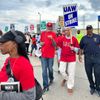President Joe Biden's $9.2 billion EV plant loan to Ford promises environmental progress and job growth. But, Ford's choice to set up in anti-union states has ignited conflicts with the United Auto Workers (UAW).
Historic UAW Strike
As of September 17th, the UAW strike against the Detroit Three automakers (General Motors, Ford, and Stellantis) is in its third day. This marks the first simultaneous strike against all three giants, reflecting growing unrest in the industrial labor sector. Despite the resumption of talks, UAW President Shawn Fain indicates slow progress. The significant labor action is all the more notable given the rising public approval of unions in recent years.
Empowered American Workforce
Amidst a domestic manufacturing revival, companies encounter a workforce more assertive about their rights. Decades of economic disparity and recent strikes point to a labor resurgence era.
Manufacturing & Freight Volumes
Despite the current industry decline, the expansion of domestic manufacturing and increased infrastructure spending points to a promising future for freight volumes. As domestic production grows, the need for transportation and freight services rises, implying more opportunities for truck drivers.
The Fallout from Yellow's Shutdown
The recent closure of Yellow, a major less-than-truckload company, has placed the spotlight on union-company dynamics. The Teamsters union's role in Yellow's operations and eventual bankruptcy has raised questions about the balance of power and decision-making in labor relations. Despite this, many believe the Teamsters will adapt, capitalizing on the expected rise in U.S. manufacturing.
A New Generation's Approach to Labor
Younger Americans, particularly millennials and Gen Zers, are playing a pivotal role in reshaping the labor landscape. Their demands aren't just monetary – they seek greater control over work rules, emphasizing the need for a more balanced work-life dynamic. This shift in priorities challenges companies to reconsider traditional work structures.
Flexibility vs. Control
Businesses argue the necessity of scheduling flexibility to remain competitive, especially in comparison with non-union establishments. The recent conflict between Yellow and the Teamsters, revolving around job conversions and expected roles, exemplifies the tension between company demands for flexibility and workers' calls for stability.
In essence, America's manufacturing push sees a balance between labor demands and company flexibility, with freight standing to benefit if it can adapt to the new labor environment.
Source: FreightWaves







